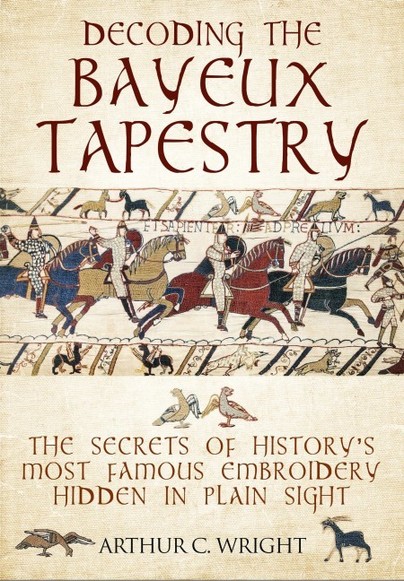Decoding the Bayeux Tapestry

The Secrets of History’s Most Famous Embroidery Hidden in Plain Sight
The story of the Norman Conquest and the Battle of Hastings as shown in the Bayeux Tapestry is arguably the most widely-known in the entire panoply of English history, and over the last 200 years there have been hundreds of books portraying the Tapestry and seeking to analyse its meanings. Yet, there is one aspect of the embroidery that has been virtually ignored or dismissed as unimportant by historians – the details in the margins. So states the introduction of the book.
The book is broken down into 11 chapters and cover the mysteries surrounding the margins of the Tapestry and cover the story in a series of chapters.
While we think of the Tapestry as telling the story of the Norman conquest, the tapestry seems to start earlier than this. The author explains the background of what is happening during the tapestry and also his integration of any hidden meanings in the marginalia.
The Tapestry itself while very interesting, doesn’t really hold much appeal to me in and of itself. The book however then goes onto discuss the accuracy of the weapons and armours as portrayed in the tapestry. The author goes to some length to highlight the different spears, lances, armours and sword being used in the tapestry to help explain the different combatants. This helps as in places the Tapestry seems to show Normans fighting themselves (well to me anyways).
This chapter is probably my favourite and one that will mean I keep the book on my bookshelf. I am sure this book will hold much more appeal for those interested in this part of Norman and Saxon history.
The last interesting thing is that the book suggests that the Tapestry was not made in Bayeux at all and in fact current scholarly thinking is that it was made in Canterbury. This is because some of the iconography used in the Tapestry could have been take from books held in Canterbury at the time.
The Appendix on the invasion fleet was an interesting piece as well as it details the invasion fleet and the author then goes to some lengths to work out the weight and number ships that must have been used to carry the invasion force.
Fascinating really. You never consider who they got there, just that they showed up.
You can buy the book here from Pen and Sword books.
Please note I was not paid to write this review but was sent a review copy of the book. All comments are my own, and the publishers have not amended the review in any way.
< BACK